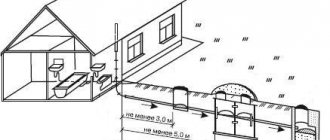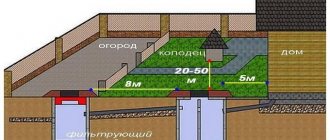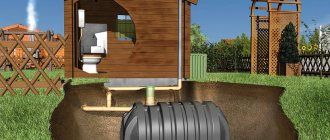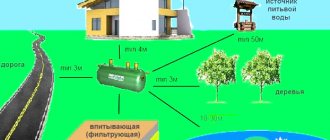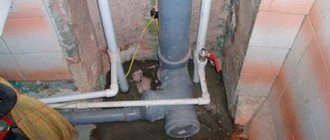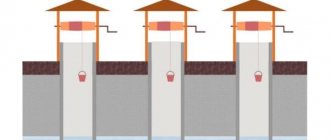People living in residential apartment buildings have more than once encountered various situations, such as the noise of a hammer drill in the morning, loud music from neighbors, and cars being washed near their houses.
Therefore, many people ask themselves the question of what norms and rules exist for the maintenance of residential buildings. What is acceptable and what is a violation.
Where does construction begin?
This article continues a series of publications devoted to the issues of construction on an individual plot of land. And so, a huge amount of work has already been done to collect information about the basic materials from which the country house will be built.
All technical and architectural ideas were implemented in the form of a ready-made project. A package of documents has been prepared and a construction permit has been issued.
Now we are closer to making the main decision - to start building our own country house.
Site plan for construction
Development Rules or Code of Practice (SP)
Numerous online forums, media publications, and even conversations with friends claim that you can’t build wherever you want. But only where the law allows. And indeed it is. Therefore, it is necessary to study, at least in general terms, the basic construction standards.
What building regulations are there? What is safety in construction? How many floors should the house be built and at what distance from the fence? In fact, these are very serious issues, ignoring which can lead to the most disastrous consequences.
Note! Now in Russia the only norms regulating building distances are the Development Rules or the Code of Rules for gardening partnerships and individual plots.
These rules have not been approved at the level of the law of the Russian Federation, so they may deviate from the Code of Rules (SP) itself. This requires appropriate decisions of the city or village council. That is why, before construction, it is advisable to contact local executive bodies to clarify the current standards.
Failure to comply with the recommendations will result in a fine and possibly further redevelopment or relocation of facilities deeper into the site. Of course, if the neighbors do not mind, and you have received their written confirmation of this fact, it is possible to build some objects closer to their private property and fence. But if neighbors change, the previous agreement is no longer valid, so the risk remains.
Country construction
The house is located in a sanitary protection zone
A difficult situation faced by a member of our portal: the house has been located near the railway since 1967, and the Sanitary Protection Zone Regulations were adopted in the 21st century.
VladneffForumHouse Member
We received a refusal to receive our notice for reconstruction due to the fact that our house is located in the sanitary protection zone of the railway (the house and land have been owned for a long time). The house has been standing since 1967, the railway even earlier, but SanPin for the sanitary protection zone was adopted already in the 21st century. Where to go next, please tell me?
Vasily Gutsev
Bad luck. The railway sanitary protection zone, unlike some other sanitary protection zones, cannot be removed or “updated”, and any reconstruction will be unauthorized. If the house after reconstruction cannot be restored to its original condition, then at the request of the local administration it can be demolished (clause 28 of the Resolution of the Plenum of the Supreme Arbitration Court of the Russian Federation, Plenum of the Supreme Arbitration Court of the Russian Federation No. 10/22 of April 29, 2010).
According to the expert, you can try to contact the administration again, relying on clause 8.20 of SP 42.13330.2011, which establishes that the SPZ can be reduced to 50 m when carrying out noise protection measures (in fact, this should be provided for in the PZZ), but It is possible that in the end you will have to achieve your goal through the courts, and there are no guarantees of success. At the same time, you can apply for approvals from railway workers and Rospotrebnadzor; this will help in communicating with the authorities, but it will not remove the sanitary protection zone itself.
Basic requirements of the Development Rules
Let's take a closer look at the basic requirements of the Development Rules. Compliance with them is desirable in order to avoid legal battles with neighbors in the future. And also so that your house / barn / bathhouse is not in danger of being moved or demolished.
Setback - construction standards
First of all, it is necessary to decide on what land plot the construction is planned. In individual construction, we are most often talking about zones of individual residential development. These areas are allocated for individual housing construction or private plots and are located within the boundaries of the settlement.
To comply with construction standards, they must be deviated from:
- at least one meter from the boundary of the site when constructing a one-story residential building;
- one and a half meters when building a two-story building;
- two meters during the construction of a three-story residential building. (Provided that the distance to the residential building located on the neighboring plot is at least 5 m).
On a note! It must be remembered that from the future residential building to the border of the neighboring plot, due to sanitary conditions, the distance must be at least 3 meters.
No law specifies exact standards for the distance between houses of any form of ownership. Therefore, we remind you that in order to choose the right location for your future home, it is better to consult with the local administration.
It is the administration that provides explanations and instructions about accepted and approved standards for individual construction in a particular city or town.
Laying the foundation in accordance with SNiP
Distance from the fence to the construction site of the house
It is also necessary to understand that a certain distance must be maintained between your house, outbuildings, the fence and the neighbor’s house.
Don't build too close or too close. For example, in order to correctly mark the foundation and begin building a house, you need to determine how many meters it is to the neighboring residential building. And find out what exactly this building is made of.
Based on these data, you can calculate the required distance from the fence to the house:
- between houses of 1st and 2nd degree of fire resistance (concrete, brick, foam concrete, sandstone) there should be from 6 meters;
- if at least one of the houses belongs to the 3rd degree of fire resistance (metal or concrete frame with fire-protected ceilings and walls), then the distance between them is 8 meters;
- in the case of constructing a wooden house or if there is one on a neighbor’s plot, the distance between them must be at least 15 meters. Such structures are very fire hazardous. Similar requirements for the location of baths. These are exactly the buildings that should not be placed close to anything, especially flammable ones.
Design in accordance with codes and regulations
Distances between objects
We emphasize that all calculations of distances between objects are made exclusively in a straight line. If the houses are not parallel to the street and opposite each other, then the clearance between them is not so significant.
When building a house on small plots, it is necessary to make an indentation deeper into or closer to the road. For what? So that your neighbor's building and yours are not on the same line. Such a deviation is quite acceptable. For private houses, fire safety standards are mandatory, and failure to comply with them entails certain liability.
It is always necessary to remember that buildings that are too close to each other are more likely to suffer from fires. Sufficient setbacks must be made to secure buildings. It is also necessary to remember that firefighters in the event of an emergency must have open access to the source of the fire.
Number of storeys for individual construction
An equally important rule for individual construction is compliance with the number of storeys of buildings. You cannot build more than 3 floors in your own home. Only if otherwise agreed in advance by the architectural control body of the local administrative unit.
The number of underground floors for such houses is not regulated. It must also be remembered that any changes to internal and external partitions (even personal property) must be coordinated with the relevant authorities.
You cannot make unauthorized changes, otherwise a fine may be issued and a requirement to return the house to its original parameters may be imposed.
Location of the house in accordance with SNiP
Standards for individual housing provided for by the site development
SNiPs are designed to ensure that buildings are as comfortable and safe as possible. SNiP 30−102−99 specifies standards for low-rise individual housing construction. In addition to the house, on such a site there may be outbuildings, perennial plantings, and underground communications. Such facilities are regulated by fire and sanitary standards. The relative position and distance of objects are taken into account. To avoid any troubles in the future when arranging and building a site, it is necessary to comply with the norms of individual housing construction.
“Red line” - this term means the line separating public areas from the building area (roads, highways, driveways).
Obtaining permission to build a house
- Purchase of residential land
- Obtaining a certificate of ownership
- Topographic survey
- Obtaining a situational plan
- Obtaining a cadastral plan
- Purchasing drawings
- Order a master plan
- Referral for approval of the master plan
Standards for the construction of a private house
Now let’s look at the standards for the construction of a private house and sanitary rules for building a site.
How much space should I make between my neighbor's fence and my own house? Regardless of the height of the fence, the building should not stand close to it. Sanitary standards suggest a distance of at least 3 meters.
Installing a fence or building a house closer to a neighbor's boundary is not allowed. There are other recommendations that you should consider even before placing objects close to each other or hedges:
- for smaller outbuildings compared to the house, the indentation can be made from 1 meter;
- the construction of utility structures for raising small livestock or poultry can be carried out at least 4 meters from the boundary fence;
- the distance from the compost pit or street toilet must be at least 8 meters in a straight line.
For many people who have recently become landowners, it becomes a real discovery that even on their own territory they cannot place buildings wherever they want. But this is a fact: the location of all buildings and even enclosing structures is regulated by legislative acts.
Brick external fence
Acceptable parameters and construction standards for fences
Let's return to SNiP 30-02-97 as amended on March 12, 2001. It contains certain standards for fence construction. Between neighbors, areas should have transparent fences, lattice or mesh. This is done with one single purpose - to prevent shading of the area.
What height should the fence be? Construction standards state that the fence should not exceed 150 centimeters. Of course, neighbors can verbally agree on a different height. But it is better to formalize the agreement in a written contract. It will have legal force in all circumstances. Even if the case goes to court.
On a note! According to general recommendations, it is advisable to make the external fence no more than 2 meters in height. The recommended transparency should be 50%.
It is worth understanding that SNiP is not considered a law as such. It only recommends specific building codes. It is important to pay attention to what rules the administration of your locality has issued based on them. This is done in order to harmonize with the climatic, regional and other characteristics of the territory.
Making a small summary, we can conclude that nothing should be built close to the fence. Unless otherwise agreed with the owner of the adjacent property. It is also worth remembering the parameters for installing fences around the perimeter of a private area:
- The height of the fence adjacent to the street is not regulated. Only you can decide how high it will rise;
- the fence at the boundary with another area made of opaque materials should be up to 75 centimeters. Above, only transparent structures can be used;
- if mutual understanding is found between the neighbors, then the height of the blind fence can be any. But it is better to record such agreements in writing.
Transparent mesh fence between areas
Requirements for kindergartens
For kindergartens, a separate SanPiN 2.4.1.3049 13 is used.
This act establishes requirements for:
- the location of the garden building;
- design and maintenance of the territory adjacent to the preschool educational institution;
- equipment of premises;
- organizing a ventilation and water supply system for gardens;
- reception of children;
- personal hygiene of workers;
- catering arrangements.
Preschool groups, after making changes, may provide for higher temperatures compared to what rules were in place previously. At present, no clear restrictions are being introduced.
Thus, to maintain the condition of the apartment building, it is necessary to use established rules affecting air exchange, heating, and water supply. Failure to comply with these provisions can lead to the formation of mold and the destruction of the house.
Individual housing construction norms
These standards for an individual house on a site are strictly regulated and mandatory.
For example, there should be no tall plants or trees close to the fence. You can only plant berries, vegetables, herbs and flowers. Thus, for growing shrubs, a distance of 1 meter is recommended, trees - 2 meters, tall trees - 3 meters or more.
Minor violations of construction standards between buildings on the site of the same owner are allowed. The owner himself decides how many meters to retreat from objects on his territory before starting construction of a new structure.
But it is imperative to adhere to sanitary and fire safety recommendations regarding fences and objects in neighboring areas!
Failure to comply may result in legal action resulting in a fine. Or perhaps demolition or relocation of the facility. In a word, it is important to comply with construction boundary standards.
On a note! If within 3 years after the construction of the object no one has challenged the correctness of its location, you can stop worrying. The deadline for filing a claim has expired. The law allows only 36 months to file a corresponding claim in court.
However, it is much better to discuss everything with your neighbors in advance and secure your agreements on paper. This will protect both parties from misunderstandings and mutual offense. True, with the advent of a new neighbor the problem will arise again. If your buildings are unduly close to his structures, the new owner may require them to be moved.
Construction of houses in violation of SNiP standards
Distances from the fence for a private house
Among the frequently asked questions on the Internet search network, there is also the question of what should be the norm for building a house from a fence. You can refer to the Code of Rules, according to which you can build your house at the following distance from:
- another house - 3 meters;
- outbuildings or chicken coop and other structures for domestic small animals (rabbits, nutria, turkeys) - 4 meters;
- other outbuildings (for example, a barn) - 3 meters;
- trees of medium height and tall trees - 2 or 4 meters. There are no norms for distances between the trees themselves, since only general recommendations for gardeners apply here.
Designing a country gazebo according to construction standards
Construction standards on the site
To avoid unexpected fines and not get into an unpleasant situation, you must initially adhere to the construction rules. To do this, you need to know how many meters you need to retreat from the house, boiler room, outbuildings, barn.
How much - from the toilet and cesspool, greenhouse, and other auxiliary structures. In a word, you need to carefully study the regulations on indentation standards.
Distance from boiler room
Since the boiler room is an object of increased danger and a source of air pollution, the distance from it to the house is approved by the relevant environmental and architectural authorities of the city.
It is necessary to approach the issue of selecting equipment for a boiler room very responsibly - ensuring fire safety is very important. It is required to place a covered box nearby with auxiliary equipment - a fire extinguisher, sand, etc. When it comes to a boiler room, fire safety cannot be neglected.
Distance from the greenhouse, chicken coop and gazebo to the fence
A greenhouse is very useful for the private sector, thanks to which it is possible to grow vegetables and herbs. And always have on the table organic, healthy food grown with your own hands. On the one hand, it seems that the greenhouse can be placed anywhere, but this is not so. A distance of 12 meters should be left between it and the residential building.
An equally popular building on a private plot is a barn. And you also can’t place it wherever you want.
The distances from the barn to the objects are as follows:
- one meter from the fence;
- three meters - from a residential building.
Buildings such as a chicken coop and outbuildings for small animals (with the exception of a dog house) should not be located next to the cellar and composting facility. Between them there must be a space of 4 meters. But the gazebo is more of a decorative structure, it is not an outbuilding.
But even it is not placed close to the house or fence. An indentation of at least 100 cm is required.
Our examples show how many nuances are hidden in buildings in the private sector. However, knowledge of the rules and strict adherence to instructions will help you avoid all pitfalls.
Building regulations
Sewerage
The last system, which also has certain sanitary requirements, is sewerage.
Virtually no residential building can do without it, and it must comply with the following requirements and rules:
- Sewage systems must be present in all residential buildings. The exception is buildings with one or two floors, which are erected in areas where there are no necessary centralized utility networks.
- For the sewer system to function, a separate water supply system must be installed that does not have any intersections with the pipes supplying water intended for drinking to the apartment.
- Sewer risers must be equipped with an exhaust hood, and its connection to the general ventilation system or chimneys is strictly prohibited.
Construction of a private house (individual housing construction) in accordance with the provisions of SNiP dated 08/04/1991
To summarize, it should be recalled that the standards for the construction of a private house are based on SNiP for the construction of a private house of individual housing construction. For single-family private houses, these provisions are also relevant.
A responsible approach and compliance with SNiP on a private site during construction guarantee minimal costs.
The following must be remembered:
- if the land is allocated for individual housing construction (IHC), only a residential building can be built on it, and not commercial buildings and structures;
- The buildings themselves and the materials from which the buildings are made must be of increased fire resistance. That is, they should not provoke fires and other adverse consequences - the formation of mold on the walls, dampness, etc.;
- it is important to ensure the accuracy of the paperwork for the land plot and for future construction;
- In addition to the house and various outbuildings, the location of composting sites, latrines, cesspools and toilets with antiseptic is allowed on the neighboring plot. Another option is the installation of dry toilets and local cleaning systems;
- it is necessary to draw up the boundaries of the site from the land of neighbors and the lands of settlements.
Construction of multi-storey residential complexes according to SNiP standards
What should the title document be?
The question is about which document can be legal and which cannot.
MaxmaximusFORUMHOUSE Member
The article says that a resolution (decision, order) of local authorities on the allocation of a land plot is needed. Can I use an order issued to a relative through whom an inheritance was received? Or should it be received personally? The problem is that currently the authorities refuse to provide such a document - is it possible to somehow influence them?
Vasliy Gutsev
Why “influence” them? The article talked about cases of initial provision of land. In this case, the document of title is the order of the authority. You have a document of title to the land - this is a certificate of inheritance rights for this land plot issued by a notary, or a court decision if you recognized the right to the plot through the court.
If the plot were to be purchased, then the title document would be a purchase and sale agreement, for example.
Construction standards for apartment buildings
Nowadays, the topic “Construction Standards for Apartment Buildings” is discussed quite often on forums. This is a very interesting question. As already noted, in 2010, specialists from the relevant department updated SanPiN in relation to private and apartment buildings, after which they established new standards.
At the same time, the standards for indoor lighting remained the same in order to avoid spot development in large cities. The new sanitary rules for private and apartment buildings have become almost ideal.
For example, according to the new standards:
- all five-story buildings must be equipped with elevators, both passenger and freight. In addition, elevators must be wheelchair accessible;
- Service stations and car services cannot be located near the local area;
- Toilets and bathrooms should not be located above residential premises (rooms). Although owners of two-level apartments can afford such luxury;
- It is prohibited to build retail facilities (stalls), restaurants and cafes near a residential building.
I would like to emphasize that this is only a small part of the total volume of rules. The standards for the construction of an apartment building are much more extensive and varied. They were developed in accordance with numerous provisions of SNiP.
The study of regulations for the construction of an apartment building deserves a separate publication, which will be prepared later.
Country house with outbuildings
IV. Hygienic requirements for heating, ventilation, microclimate and indoor air environment
4.1. Heating and ventilation systems must ensure acceptable microclimate and indoor air conditions. Optimal and permissible microclimate parameters in residential buildings are given in the appendix. to these sanitary rules.
(Changed edition. Amendment No. 1)
4.2. Heating systems must ensure uniform heating of the air in the premises throughout the entire heating period, do not create odors, do not pollute the indoor air with harmful substances released during operation, do not create additional noise, and must be accessible for routine repairs and maintenance.
4.3. (Deleted. Change No. 1)
4.4. Heating devices should be easily accessible for cleaning. For water heating, the surface temperature of heating devices should not exceed 90 °C. For devices with a heating surface temperature of more than 75 °C, protective guards must be provided.
4.5. The premises of the first floors of residential buildings located in climatic region I must have heating systems for uniform heating of the floor surface.
4.6. The installation of autonomous boiler houses for heat supply to residential buildings is permitted subject to compliance with hygienic requirements for the quality of atmospheric air in populated areas, hygienic standards for noise and vibration.
4.7. Natural ventilation of residential premises should be carried out by air flow through vents, transoms, or through special openings in window sashes and ventilation ducts. Duct exhaust openings should be provided in kitchens, bathrooms, toilets and drying cabinets.
The design of the ventilation system must prevent the flow of air from one apartment to another.
It is not allowed to combine the ventilation ducts of kitchens and sanitary facilities with living rooms.
4.8. Ventilation of objects located in residential buildings must be autonomous. It is allowed to connect the exhaust ventilation of public premises that do not have harmful emissions to the general exhaust system of a residential building.
4.9. Exhaust ventilation shafts must protrude above the ridge of the roof or flat roof to a height of at least 1 m.
4.10. The concentration of chemicals in the air of residential premises when buildings are put into operation should not exceed the average daily maximum permissible concentrations (hereinafter referred to as MPCs) of pollutants established for the atmospheric air of populated areas, and in the absence of average daily MPCs, not exceed the maximum one-time MPCs or estimated safe exposure levels ( hereinafter referred to as OBUV).
Operation of private and apartment buildings
Today, SanPiNs have been established at the legislative level, which determine the construction and operation of private and apartment buildings. These standards establish acceptable boundaries that create a safe and comfortable living environment for the residents of the house.
In addition, SanPiNs establish various parameters, such as lighting levels, air humidity, air exchange characteristics, safety and much more. If you follow all the rules and regulations, you can live in the house without harm to your health.
Sanitary standards and parameters must be taken into account already at the stage of developing a house project. In many ways, the choice of equipment and materials that will be used for construction and as finishing of premises depends on these standards.
Noise
The presence of noise makes the stay of residents inside the building uncomfortable, and with a systematic and significant violation of the relevant standards, there is a risk of health problems.
In this regard, the following requirements are imposed on the noise regime:
- When choosing a site for construction of a residential building, it is necessary to pay attention to a number of physical factors, including the presence of natural or artificially created noise, which should not exceed the levels established by current legislation.
- All engineering equipment and utility communications that are located inside the building must also comply with permissible noise levels.
- Heating and other systems must be silent even during operation.
- If there are windows in a building that overlook roads or other sources of noise, an inspection is required to ensure compliance with legal standards. In cases where the noise level exceeds permissible levels, a set of measures aimed at suppressing it must be taken.
- When carrying out various repairs and other work by residents of the house, they must also make sure that noise standards are observed.
What are sanitary rules and regulations (SaPiNs)
Modern residential buildings are high-tech engineering structures and have nothing in common with ancient dwellings. But the more technologically advanced the building, the more carefully it is necessary to control its basic parameters and characteristics.
It was to systematize and take into account all the norms that SanPiNs were introduced. The main parameters that must be observed include the microclimate and ventilation system.
Temperature conditions in residential premises
The main characteristic that determines the convenience and comfort of living is the microclimate of the room. The room temperature should always be within normal limits. Otherwise, living in an apartment will be uncomfortable or even dangerous.
Unfortunately, in Russia this norm is not always observed. In particular, due to rapid changes in ambient temperature. And yet, according to regulations, the temperature in the rooms should be 18 degrees, and in the bathroom 25 degrees. These parameters apply to all residential premises.
On a note! If the temperature regime is not respected, you can demand a reduction in heating fees.
Ventilation in residential premises
Any living space must be provided with good ventilation. According to standards, air exchange parameters should be three cubic meters per hour per square meter.
Town Planning Code of the Russian Federation
The building footprint has decreased
The developer submitted a Notification for one area of the house, but in fact reduced it slightly.
Elpiko FORUMHOUSE Member
I submitted a Notification for 150 square meters, but built 128. That is, I slightly reduced the area, but in the indentations and in the “spot” of the house, which is 150 m2. From practice, theory - will there be a refusal?
Vasily Gutsev
From theory, you need to receive a new notification about construction (Clause 14, Article 51.1 of the Civil Code of the Russian Federation). I can’t suggest any practical experience on this issue; it is just beginning to take shape.
Parking a car near the house: the effect of the law in 2021
The law allows residents of the house to install barriers at the entrance to the yard. This will protect them from the cars of residents and guests from neighboring buildings who could not find a place in their parking pocket. However, the purchase and maintenance of the barrier is not included in the utility fee. Its installation can be done after a meeting of all owners and collection of signatures. Consent to the barrier must be given by 2/3 of all owners. Money for the installation and maintenance of this equipment is collected from all apartments in the building in equal shares.
We recommend reading: Visa Appeal Examples
As a result, the traffic police officer will draw up protocols and issue fines to all violators. Sometimes car owners do not comply with sanitary standards, then it is also worth taking photos and videos of incorrectly parked cars and contacting the appropriate services.
